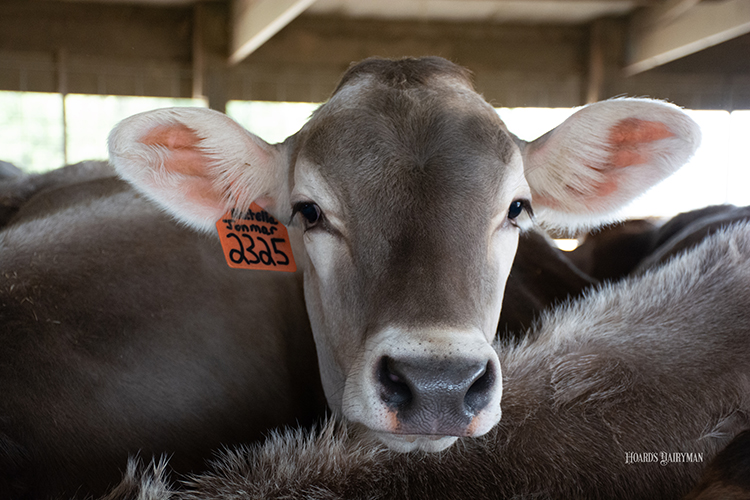
More than 150 dairy genetic enthusiasts gathered on October 4, 2023, at World Dairy Expo for the ninth annual Industry Meeting of the Council on Dairy Cattle Breeding (CDCB). Among the most popular presentations were two talks on current research to define new traits, develop data pipelines, and produce genetic evaluations for traits of economic and societal importance. Geneticists Kristen Parker Gaddis and Asha Miles presented the research updates from CDCB and USDA’s Animal Genomics and Improvement Laboratory (AGIL), respectively.
Over the past five years, CDCB has introduced several new traits to improve the health and profitability of dairy herds worldwide. In 2018, CDCB evaluations for resistance to six health disorders were published for the first time for Holsteins. Jerseys followed in 2020, then Brown Swiss in 2022. Feed Saved and Residual Feed Intake traits launched in 2020 to leverage genetic variation for feed efficiency and help reduce the largest expense for most farms. The formula for the national genetic index, Net Merit (NM$), was updated in 2021 to incorporate newer traits and updated economic values.
Each of these steps forward has been possible through collaboration among U.S. dairy producers and organizations that serve them, along with research partnerships between CDCB, USDA AGIL, and numerous universities. That precompetitive collaboration is unique to the U.S. and was celebrated during the recent CDCB meeting, recognizing the 10-year anniversary since the distribution of genetic evaluations and stewardship of the national cooperator database transferred from USDA to CDCB.
Future-focused genetic selection
While we celebrate the past decade, we will not rest on our laurels. Miles and Parker Gaddis shared progress on the research underway to enhance these newer traits and develop additional traits and genetic selection strategies.
1. Feed efficiency and enteric methane emissions
The 2020 introduction of Feed Saved and Residual Feed Intake, and their inclusion in NM$ in 2021, allowed producers to genetically select for animals that use less feed while producing the same amount of milk. Additional phenotypes (or performance data) continue to be collected at five research institutions, strengthening the reliability and accuracy of these traits.
Further, the research focus shifts to a related goal: reducing enteric methane emissions. Funding made possible through the Greener Cattle Initiative and CDCB was recently awarded to Francisco Peñagaricano at the University of Wisconsin-Madison to study enteric methane production, define a genetic trait, and inform future genetic evaluations. Peñagaricano discussed this research in further detail during the October 4 meeting; view this recording to learn more.
2. Resistance to Johne’s disease
A 2022 feasibility study concluded that genetic selection can be utilized to improve resistance to Johne’s disease. The next steps are to further evaluate the best model going forward and to perform a test run with the currently available data. There are hurdles to overcome to develop a routine data pipeline and address data sensitivity concerns before a trait can be introduced.
3. Cow mobility and hoof health
Research and data collection on mobility and hoof health continues at herds in Minnesota and Iowa, and soon in California and Arizona. The data collected on these farms addresses how mobility scoring measured by CattleEye correlates with lameness and hoof health (through trimmer-reported lesions). The goal is to define a trait that aids in selection to reduce lameness and create a stable, continuous data pipeline to support genetic evaluations.
4. Milking speed
In 2021, CDCB appointed a task force to investigate the feasibility of implementing genetic evaluations for milking speed in the U.S. Data collected to date for this project represents roughly 300 herds with a total of 230,000 cows and more than 40 million observations. This analysis quickly becomes complex with multiple breeds and various equipment manufacturers included in the variables, which must be harmonized to form a single trait. The preliminary results suggest that the heritability of a predicted transmitting ability (PTA) for milking speed is 0.37, and there is a low correlation to the current NM$, which suggests that genetic selection for milking speed is a new opportunity to improve parlor flow and herd management.
5. Standardizing lactation yields
Standardizing lactation yields is currently done through 305-day mature equivalent (305-ME) estimations. The factors included in 305-ME estimations were last updated nearly 30 years ago in 1994. In December 2023, it is anticipated that new factors standardizing lactation yields will be available and update season-region figures and age-parity figures. This new estimation will be referred to as “305-36mo.” This update is only the first step in more comprehensive updates to be implemented to reflect current dairy conditions, thanks to a collaboration between USDA AGIL, CDCB, and the National Dairy Herd Information Association (NDHIA).
More information about these research projects and other topics discussed during the 2023 CDCB Industry Meeting is available at https://uscdcb.com/2023-industry-meeting/.
To comment, email your remarks to intel@hoards.com.
(c) Hoard's Dairyman Intel 2023
October 19, 2023








